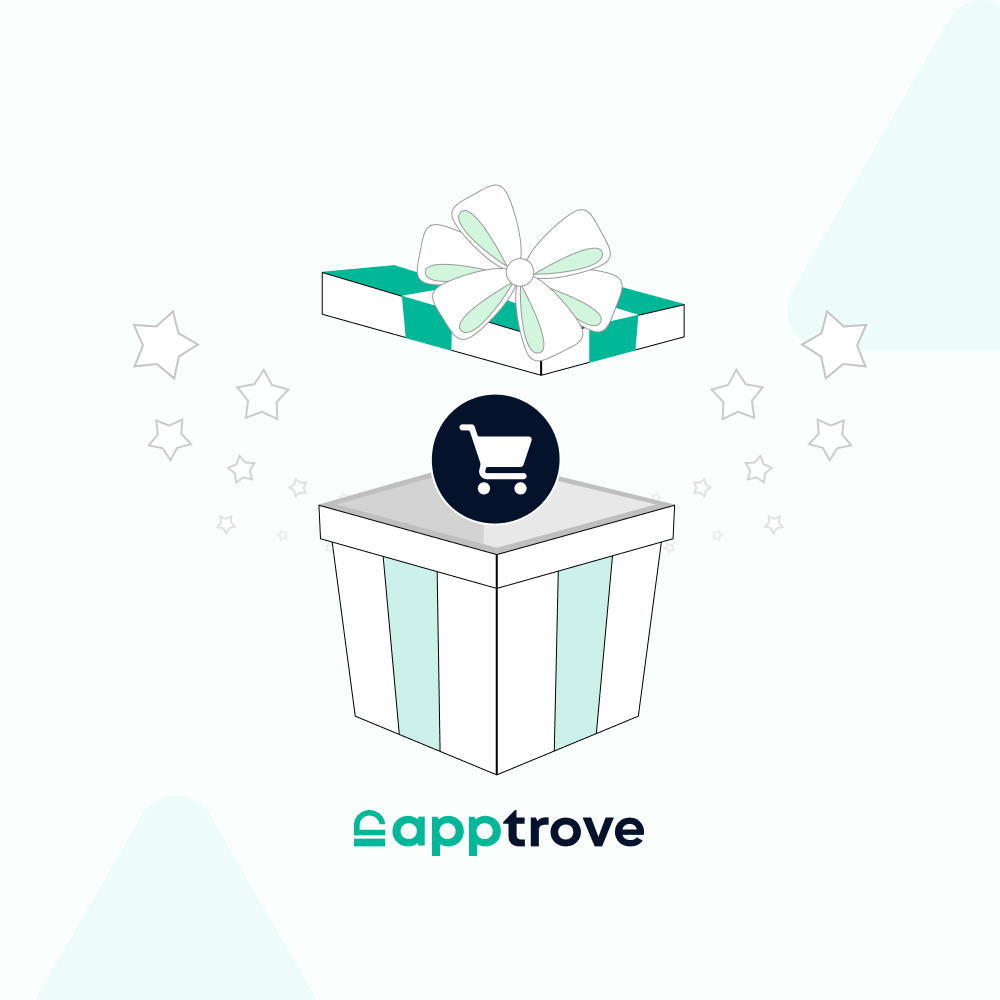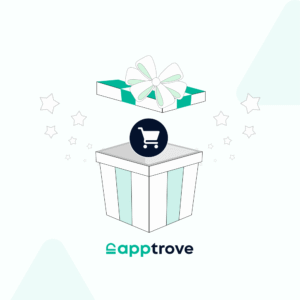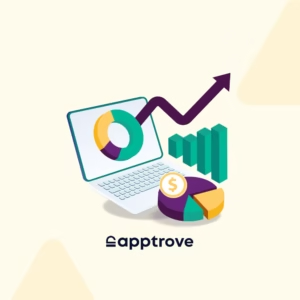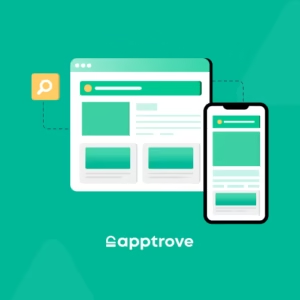Simply having a great product is insufficient when it comes to mobile apps. To ensure long-term growth and increase your app’s success, you need a successful marketing strategy plan to go along with it.
Here, we’ll discuss the significance of combining ASO and paid user acquisition to support the growth of mobile apps.
What Is ASO?
ASO, or App Store Optimization, is a technique for enhancing your app’s potential for downloads and user engagement through the app store itself.
Similar to SEO, ASO works by increasing your app’s visibility so that it appears higher than its rivals in search results on websites like the App Store and Google Play Store.
Given that 70% of mobile users discover apps via app store search features, it is obvious why ASO is crucial for ensuring growth.
And while ASO lays the foundation, it’s the integration with smart, data-driven user acquisition that truly accelerates scale. That’s where platforms like Apptrove come in—helping teams connect the dots between discoverability, installs, and long-term engagement with the right tools and insights.
Search Engine Optimization vs. App Store Optimization
Differences between search engine optimization (SEO) and app store optimization (ASO)
- ASO is a great way to make your app discoverable to millions of potential customers and can be used for both iOS and Android mobile app stores.
- Understanding the search terms used by your potential customers is essential for the success of ASO.
- Additionally, you will be able to modify your app’s description and visuals to appear more prominently in the app store’s search results, presenting it as the more reliable and appropriate option.
What Is Paid User Acquisition?
Paid user acquisition, as the name implies, uses paid advertising to drive traffic to your app and draw users.
Paid user acquisition has the potential to generate a sizable return on investment, thanks to highly targeted advertising aimed at an appropriate clientele.
To support steady growth, it can also be geared toward attracting new users and repeat customers.
If you want paid user acquisition to be successful, you must know exactly where your users are coming from in order to choose the best channel for your advertising.
In order to reach your target audience, you can do it by using Facebook, Google App Campaigns or other developing platforms.
As a starting point, run ads in native channels like the Google Play Store and Apple App Store. Your potential customers are already searching for apps to download from the app stores, which indicates higher search intent. By displaying your app ad, you can increase the likelihood that users will download your app.
Successfully boosting brand awareness is yet another important benefit of paid user acquisition. Additionally, paid user acquisition allows you to increase visibility through product placement outside of the app store, establishing your app’s reputation as the user’s preferred option.
How To Build An ASO Strategy?
Use The Appropriate Keywords
When it comes to organic discovery in an app store, keywords are important. Identify the keywords that potential users are likely to use first. These are likely the keywords that your rivals are also using. You can use an ASO tool to research your competitors’ keyword strategies and find relevant keywords for your app. With the aid of these tools, you can measure many of the metrics we’ll talk about later.
There are restrictions on what you can put here, so be selective with your keywords. Finding undiscovered keywords can give you a big advantage. Avoid using the same keywords twice in your app name or subtitle because they will only be taken into account once. Additionally, think about including relevant long-tail keywords. Longer and more precise keyword phrases with higher user intent tend to have lower search volume. Despite the lower volume, there is less competition and the more focused intent results in higher conversion rates.
Improve The Title And Description Of Your Page
The most crucial step when it comes to metadata is title optimization. This can result in a 15% increase in downloads.
The name of your app and the top keywords you chose in step one should be included in your title, which should be as memorable as possible. Keep in mind that your title will be cut off after 25 characters when it appears in App Store results.
Write a concise and compelling paragraph and/or list that focuses on your app’s unique features for the description. Consider what problem your app solves, which features users enjoy, and what makes your app unique, and then try to convey all of this in an easy-to-read manner.
For people who are scanning quickly, use bullet points or break up the text. Feel free to add social proof, such as awards or quotes from respected sources or contented customers (but place these closer to the end).
Incorporate Eye-Catching Screenshots And In-App Examples
Due to the visual nature of mobile screens, you’ll need to use some eye-catching graphics to draw in potential customers. Your images will be your main tool for attracting attention and gaining installs because less than 2% of users tap the “Read More” button to read your entire description.
Visuals that are stunning and compelling will put you far ahead of the competition and can boost download rates by 17–24%. Use unique color schemes and emphasize distinguishing visual elements. Most users want to see high-quality screenshots that show them how to use your app and the issues it resolves.
It’s time to show off all the effort your team put into the design, UI, and UX, as well as the killer features!
When Video Is An Option, Why Use A Static Card?
A video on an app’s page can boost downloads by up to 35%, in case we forgot to mention that. You’ll need a video if you want to stand a good chance of competing because the vast majority of app pages on both app stores currently feature video.
Make and include a brief, snappy, eye-catching video that provides the best representation of your in-app experience. Avoid highlighting specific events or any other out-of-date content if you want your video to be evergreen (continually relevant).
All verticals need compelling creatives, but the fiercely contested gaming industry especially needs them. It’s important to emphasize actual gameplay in games rather than elaborate cutscenes or animations.
Optimize And Test Your Creative Resources
You’ve already produced all of the content required for your app product pages, including a catchy title, a keyword-focused description, images, and even a video. To increase your conversion rate, test and refine each of these strategies right away. The Play Store and iOS 15 has given app marketers some ability to A/B test their marketing materials.
The Play Store offers the broadest range of features, also referred to as store listing experiments in the Play Console. With these, you can test anything, including images, descriptions that are specific to a particular region, icons, and more.
Test your creative assets using a 90/10 split, which involves sending 90% of visitors to your control page and 10% to the new variant you are testing. It is typically viewed as a best practice.
You can better optimize your listings to increase conversions by making data-driven decisions and continuously making changes to your creatives. It’s also important to keep in mind that success on the Play Store might not translate exactly to success on the App Store. Therefore, even though testing in the Play Console can inform your App Store creative, don’t forget to test specifically for the App Store as well (more on the new features for the App Store A/B testing below).
iOS 15 Changes To ASO
In the past year, Apple has significantly changed the landscape of Apptrove, but with the release of iOS 15, they’ve added some new features for UA and ASO in the App Store: With the help of the new Product Page Optimization (PPO) feature in iOS 15, marketers can test three different variations of product page creatives on the App Store. Marketers can use App Analytics in App Store Connect to view impressions, conversion rates, and improvements while A/B testing icons, screenshots, and app previews.
Timely events within apps are referred to as in-app events, and examples include movie premieres, gaming tournaments, and live-streamed activities. Marketers will be able to include event cards for in-app events on their product pages starting in the fall of 2021. This will help keep your page current and relevant and provide a new way to draw in potential users.
How can you run a successful ASO program?
Improve your net promoter score.
The percentage of users who are likely to recommend your app to others is calculated as
your Net Promoter Score (NPS). If you want to move up in the app store rankings, you should take this metric into account.
To begin calculating your score, ask each of your users one simple question about how likely they are to recommend your app, ranging from 1 to 10.

Utilize KIPS That Matter To Gauge Your Success
Measurement is critical to the success of any marketing strategy. There will always be room for more analysis, testing, and improvement of your ASO strategy.
The following are the key KPIs to consider:
Organic Conversion Rate:
This represents the proportion of users who download your app directly from an app store.
A crucial way to determine whether or not you’re moving in the right direction is to compare your overall conversion rate to the performance of the average app in your category. High conversion rates demonstrate to Apple and Google how popular your app is with users. Because the app stores don’t want to sell their customers inferior products, apps with low or declining conversion rates will fall in the in-app store rankings.
Keyword Search Rankings:
How simple is it for your audience to find your application?
This demonstrates whether or not you selected wise keywords. The likelihood of downloads increases as your keyword ranks higher in user searches. As a general rule, try to keep the keyword you and routinely check the app stores’ autofill suggestions.
Visibility Score:
This metric displays your app’s potential traffic (impressions) and whether it is living up to
that potential. Your keyword performance, category ranking performance, ratings, and reviews are all factored into your visibility score. You can begin to comprehend your app’s ranking position and how to convert visibility into downloads by comparing the progression of your app’s visibility to that of your rivals and similar apps.
Download Velocity:
This is the total number of installs your app receives over a specific period of time. Your app will rank higher in the Play Store or App Store if the velocity is higher. This explains why well-liked apps that receive lots of daily downloads are consistently listed among the top apps.
Set Reasonable Goals For Your ASO Efforts.
Similar to SEO, ASO is an effective tool for reducing UA costs, and there are constantly fresh chances to improve your ranking by optimizing your keywords, screenshots, descriptions, and icons. To better understand where your app is succeeding and where it is struggling, it is recommended that you regularly create ASO reports.
Installs should typically increase between one and three months after implementation if your ASO strategy is sound, and you should anticipate that any organic growth from your ASO efforts will be proportional to your paid campaign efforts.
You also need to keep up with ASO, especially when it comes to updating and revising the creative elements in your listings, such as the copy and images. Add any fresh occasions, trends, or ideas periodically that are pertinent to your app. Your copy and design must both be kept current, just like your website, or they risk losing their effectiveness over time.
Also, keep an eye on your rivals. Your own ASO strategy must take into account the categories and keywords that your competitors prioritize. You can concentrate on ranking new keywords before your competitors do by examining changes made by your rivals and the effects those changes are having.
Understnad The Relationship Between ASO And Paid UA/APP Store Advertising.
Potential users can find your app through advertisements on Google App Campaigns and Apple Search Ads (ASA) when they are on the respective app store. It’s crucial to conduct research, bid on the appropriate keywords for your app, and encourage conversions with compelling creatives when it comes to paid user acquisition on these networks.
Potential users can find your app through advertisements on Google App Campaigns and Apple Search Ads (ASA) when they are on the respective app store. It’s crucial to conduct research, bid on the appropriate keywords for your app, and encourage conversions with compelling creatives when it comes to paid user acquisition on these networks.
Before we move on to the next section, where we’ll discuss paid campaigns in greater detail, we just wanted to make clear how closely related and interdependent ASO and paid UA are Paid advertisements should support your app store listing while integrating with your ASO strategy.
Additionally, keep in mind that even if your ASO is flawless and you are ranked first for your chosen keyword, a paid advertisement may overtake you for the top spot in an app store, with your #1 organically ranked app appearing in the second position below the paid advertisement. Running brand protection campaigns will stop this from happening and keep your app at the top by preventing rivals from outbidding you on ASA or Google App Campaigns that would undermine your ASO efforts.
Understanding Organic Uplift
A percentage that reflects the relationship between organic and non-organic installs for your app is called an organic uplift. In essence, it serves as a gauge for how many more organic users are likely to download your app as a result of the paid promotion.
Search Engine Optimization
Increase traffic to your app store page by building backlinks: Backlinks are links to your listing that are posted on other websites, most often blogs. Backlinks should be placed strategically rather than randomly, on pages that are relevant to your listing and where doing so makes sense and is beneficial. These links will help you improve your keyword rankings in addition to driving clicks to your listing.
Why Should You Combine ASO With Paid Acquisition?
Similar to most industries, building a loyal and diverse customer base requires maximizing a combination of both organic and paid acquisition.
You want your app to be easily discoverable by potential users and to draw the most relevant users who will stick around and continue to generate income.
It’s important to keep in mind that, regardless of what you do, people will find your app store product page. For this reason, you require a strong ASO foundation to keep a steady flow of high-quality users through various channels.
Paid user acquisition will also aid in strengthening the effectiveness of your app, improving keyword rankings, and increasing the number of organic installs. You can achieve the ideal balance in conversions while steadily increasing traffic and engagement by employing a multifaceted strategy.
Effective ASO can enhance every other UA channel. It really can’t be overstated how important an optimized listing is in lowering your cost per conversion because users who found your app through an advertisement typically have lower conversion and retention rates than users who found you organically. Effective ASO can enhance every other UA channel.
How to combine ASO and Paid Acquisition?
ASO and paid user acquisition go hand in hand, and combining the two is crucial for securing installs and expanding the presence of your app.
Let us guide you through the growth framework’s five steps.
The growth framework at a glance.

Focus On App Store Optimization
You should start with optimization when creating your plan to accelerate the growth of your mobile application. Prior to attracting potential users to your app through advertising, your app must be highly visible and stand out from the crowd. To achieve this, you must carefully choose and incorporate keywords that are deeply rooted in your customer journeys, then reflect this in the title and description of your app. In order to further improve your ranking and fortify your brand identity, you should also choose sharp visuals to highlight your best features and encourage user ratings and reviews. Building strong foundations with slick ASO will help you secure growth while maximizing your investment in paid user acquisition.
Level Up With Paid User Acquisition
Once you’re satisfied that you’ve successfully optimized your app, it’s time to advance with paid acquisition to significantly accelerate growth. This is your chance to draw in your primary target market, get them to download your app, and keep a steady flow of engaged, high-quality users. Driving installs and user engagement also has a knock-on effect on your rankings, which will increase organic installs. This is the beauty of paid user acquisition. You can increase the visibility of your app and accelerate your growth by including paid user acquisition in your strategy.
Deepen Your App Marketing Strategy
Flexibility is necessary in marketing strategies. For your strategy to be successful over the long term and consistently, you must keep an eye on how it is performing. Keep abreast of the most recent trends, your competitors’ best and worst practices, and the preferences of your current and potential customers. You can evolve along with your customers by gathering and examining data on the effectiveness of your paid acquisition and ASO strategies.
Adapt your creatives, change the keyword density, concentrate your investment on the channels that perform the best, and test out new market opportunities without hesitation.
Be Data-driven With Comparative Analysis
Get a picture of how your channels are performing before developing your strategy. Determine the most effective channel based on average CPI and the overall number of installs. As you analyze the data, keep the following in mind:
- Determine the most effective keyword and messaging strategies by comparing your channels.
- Determine which keywords are giving your store listing good rankings as part of ASO.
- Determine which keywords in Search Ads are generating downloads.
- Find out which messages perform the best conversions as part of paid user acquisition.
- The data will reveal the true performance of your app, and you can use the insights to guide your future marketing efforts.
In order to successfully adapt in line with trends, it will also involve continuous testing to better understand the strengths and weaknesses of your strategy, your messaging, and the platforms you’re using.
As you develop your strategy to maintain engagement and draw in new customers, it’s a great idea to pay attention to reviews in order to better understand your users and their needs. Always read the app store reviews. Receive alerts each time a new user review is posted for your app.
Analyze Results
The last step is to make sure you analyze your campaign results after putting everything else in place. Your ability to keep moving your strategy forward and take advantage of growth opportunities will be strengthened by understanding and reflecting on your results. Your chances of success increase as you gain a better understanding of both your performance and your target audience.
Conclusion
Creating and maintaining mobile app growth requires a delicate balancing act between ASO and paid user acquisition. Both these components are crucial in order to advance your app’s success and produce consistent revenue. Don’t undervalue the role that ASO plays in your campaign as you move forward withyour strategy, and make careful use of your insights to target your intended audience through paid acquisition precisely.
Don’t be afraid to change course if the data points in a different direction. Be brave in your approach.
Also, you can check out our other Guide on Everything you need to know about Deep Linking
Besides, you can also reach us with your questions or queries. We would be happy to help!!






